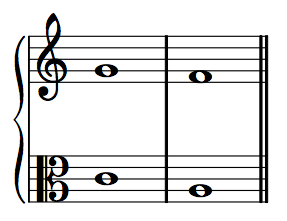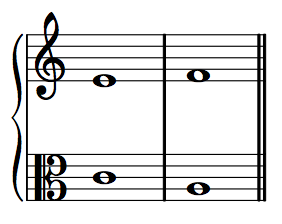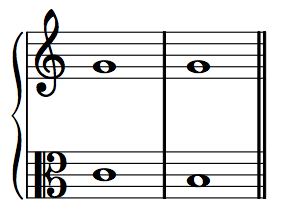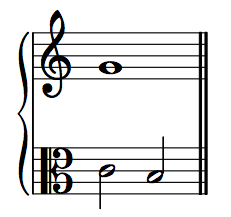Integrated Music Theory 2023-24
Discussion 5a - Introduction to Counterpoint
Contrapuntal Clamor
“What is counterpoint?”
- The process of weaving together simultaneous melodies.
Homophony vs Polyphony:
- Homophonic textures is created when one or multiple voices are all singing around the same central idea.
- Polyphony is present when inner voices other than the melody are present and have rhythms and pitches that are more contrasting from the main melody.
“How is a Perfect 4th a dissonant interval?”
- Really, it depends on the context. When the use of a perfect 4th undermines the harmonic context it is in, that would be considered dissonance. For example, if you are in a major key and you sing “Do Fa”, it can sound like you are implying Fa to be the new tonic, which undermines the current harmonic context, making it dissonant.
- In many other cases, the presence of a perfect 4th can be totally consonant. In the same example, if you had sung “So Do” (coming from below Do), it strongly emphasizes the current tonic and would be considered consonant.
- Honestly, the consonance or dissonance of any interval is subjective.
Types of contrapuntal motion
- Parallel: two voices moving in the same direction and by the same size of interval (not necessarily the same quality)
- Contrary: two notes moving in the opposite direction from each other. Intervals don’t matter
- Static: no movement in either voice
- Oblique: one voice is stationary, the other moves in either direction
- Similar: same direction, different interval sizes
Similar and Perfect are not connected. They mean different things and aren’t used in the same situations as each other.
Further reading
From Open Music Theory
Types of contrapuntal motion
There are four types of contrapuntal motion between two musical lines. Differentiating these four types of motion is essential to generating good voice-leading, both strict and free.
In parallel motion, two voices move in the same direction by the same generic interval. For example, the following two voices both move up by a step. Note also that both dyads form the same generic interval (sixth). This will always be true when two voices move in parallel motion.

In similar motion, also called direct motion, two voices move in the same direction, but by different intervals. For example, the following two voices both move down, but the upper voice moves by step while the lower voice moves by leap. Note also that the two dyads are different generic intervals. This will always be the case with similar or direct motion.

In contrary motion, two voices move in opposite directions—one up, the other down.

In oblique motion, one voice is stationary, while the other voice moves (in either direction). The stationary tone may or may not be rearticulated.

or
